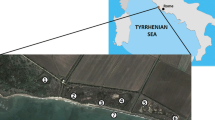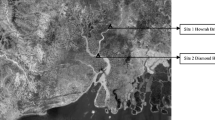Abstract
Water and sediment samples from Charlotte Harbor, Florida were examined for the autochthonous human pathogen, Vibrio vulnificus, for 1 year (March 1997–February 1998). Within the estuary, mean water column levels of V. vulnificus ranged between 58 CFU/100 ml and 1.21×103 CFU/100 ml while sediment levels were up to 2 orders of magnitude greater.Vibrio vulnificus was detected throughout the year in Charlotte Harbor. The highest concentrations (5.14×103 CFU/100 ml) of the year were found at warm temperatures and moderate salinities in September. The lowest mean concentration occurred in March at 26 CFU/100 ml. Although concentrations of Vibrio vulnificus were positively correlated with temperature, salinity was a more important factor influencing variability of this organism. In Charlotte Harbor, an optimal salinity of 15 psu (practical salinity units) was found for recovery of high concentrations of the pathogen. There were significant positive and negative correlations above and below 15 psu, respectively. Results from this study suggest that unlike temperate estuaries, in regions of moderate year round temperatures, such as the tropics or subtropics, salinity strongly controls the geographical and seasonal distribution of V. vulnificus between sediment and water column.
Similar content being viewed by others
References
Arias, C. R., M. C. Macián, R. Aznar, E. Garay & M. J. Pujalte, 1999. Low incidence of Vibrio vulnificus among Vibrio isolates from seawater and shellfish of the western Mediterranean coast. J. Appl. Microbiol. 86: 125–134.
Brauns, L. A. & J. D. Oliver, 1994. Polymerase chain reaction of whole cell lysates for the detection of Vibrio vulnificus. Food Biotechnol. 81: 1–6.
Coleman, S. S., D. M. Melanson, E. G. Biosca & J. D. Oliver, 1996. Detection of Vibrio vulnificus biotypes 1 and 2 in eels and oysters by PCR amplification. Appl. Envir. Microbiol. 62: 1378–1382.
DePaola, A., G. M. Capers & D. Alexander, 1994. Densities of Vibrio vulnificus in the intestines of fish from the U.S. Gulf coast. Appl. Envir. Microbiol. 60: 984–988.
Gerba C. P. & J. S. McLeod, 1976. Effect of sediments on the survival of Escherichia coli in marine waters. Appl. Envir. Microbiol. 32: 114–120.
Ghinsberg, R. C., R. Dror & Y. Nitzan, 1999. Isolation of Vibrio vulnificus from seawater and sand along the Dan region coast of the Mediterranean. Microbios 97: 7–17.
Høi, L., J. L. Larsen & I. Dalsgaard, 1998. Occurrence of Vibrio vulnificus biotypes in Danish marine environments. Appl. Envir. Microbiol. 64: 7–13.
Kaspar, C. W. & M. L. Tamplin, 1993. Effects of temperature and salinity on the survival of Vibrio vulnificus in seawater and shellfish. Appl. Envir. Microbiol. 59: 2425–2429.
Kelly, M. T., 1982. Effect of temperature and salinity on Vibrio (Beneckea) vulnificus occurrence in a Gulf coast environment. Appl. Envir. Microbiol. 44: 820–824.
Koh, E. L., J.-H. Huyn & P. A. LaRock, 1994. Pertinence of indicator organisms and sampling variables to Vibrio concentrations. Appl. Envir. Microbiol. 60: 3897–3900.
Lipp, E. K. & R. Hammond, 1996. Ecology and virulence of halophilic vibrios in Florida. Flor. J. Envir. Health 153: 6–9.
Lipp, E. K., R. Kurz, R. Vincent, C. Rodriguez-Palacios, S. R. Farrah & J. B. Rose, In Press. The effects of seasonal variability and weather on microbial fecal pollution and enteric pathogens in a subtropical estuary. Estuaries.
Lipp, E. K. & J. B. Rose, 1997. The role of seafood in foodborne diseases in the United States of America. Revue scientifique et technicale, Office internationale des Epizooties 16: 620–640.
Massad, G. & J. D. Oliver, 1987. New selective and differential medium for Vibrio cholerae and Vibrio vulnificus. Appl. Envir. Microbiol. 53: 2262–2264.
Motes, M. L., A. DePaola, D. W. Cook, J. E. Veazey, J. C. Hunsicker, W. E. Garthwright, R. J. Blodgett & S. J. Chirtel, 1998. Influence of water temperature and salinity on Vibrio vulnificus in northern Gulf and Atlantic coast oysters. Appl. Envir. Microbiol. 64: 1459–1465.
Oliver, J. D., 1995. The viable but non-culturable state in the human pathogen Vibrio vulnificus. FEMSMicrobial Ecol. 133: 203–208.
Oliver, J. D., F. Hite, D. McDougald, N. L. Andon & L.M. Simpson, 1995. Entry into, and resuscitation from, the viable but nonculturable state by Vibrio vulnificus in an estuarine environment. Appl. Envir. Microbiol. 61: 2624–2630.
O'Neill, K. R., S. H. Jones & D. J. Grimes, 1990. Incidence of Vibrio vulnificus in northern New England water and shellfish. FEMS Microbiol. Lett. 72: 163–168.
Peele, T. C., 1936. Adsorption of bacteria by soils. Cornell University Agricultural Experiment Station. Memoir 197: 17 pp.
Rivera, S., T. Lugo & C. Hazen, 1989. Autoecology of Vibrio vulnificus and Vibrio parahaemolyticus in tropical waters. Wat. Res. 23: 923–931.
Schmidt, N., E. K. Lipp, J. B. Rose & M. E. Luther, 2001. Analysis of ENSO related trends in Florida precipitation and streamflow. J. Climate 14: 615–628.
Shukla, B. N., D. V. Singh & S. C. Snayal, 1995. Attachment of non-culturable toxigenic Vibrio cholerae O1 and non-O1 and Aeromonas spp. to the aquatic arthropod Gerris spinolae and plants in the River Ganga, Varanasi. FEMS Immunol. Med. Microbiol. 12: 113–120. 173
Tamplin, M., G. E. Rodrick, N. J. Blake & T. Cuba, 1982. Isolation and characterization of Vibrio vulnificus from two Florida estuaries. Appl. Envir. Microbiol. 44: 1466–1470.
Williams, L. A. & P. A. LaRock, 1985. Temporal occurrence of Vibrio species and Aeromonas hydrophila in estuarine sediments. Appl. Envir. Microbiol. 50: 1490–1495.
Whitman, R. J. & G. J. Flick, 1995. Microbial contamination of shellfish: Prevalence, risk to human health and control strategies. Ann. Rev. Public Health 16: 123–140.
Wright, A. C., G. A. Micell, W. L. Landry, J. B. Christy, W. D. Watkins & J. G. Morris Jr., 1993. Rapid identification of Vibrio vulnificus on nonselective media with an alkaline phosphataselabeled oligonucleotide probe. Appl. Envir. Microbiol. 59(2): 541–546.
Wright, A. C., R. T. Hill, J. A. Johnson, M. C. Roghman, R. R. Colwell & J. G. Morris Jr., 1996. Distribution of Vibrio vulnificus in the Chesapeake Bay. Appl. Envir. Microbiol. 62: 717–724.
Yamamoto, K., A. C. Wright, J. B. Kaper & J. G. Morris Jr., 1990. The cytolysin gene of Vibrio vulnificus sequence and relationship to the Vibrio cholerae El Tor hemolysin gene. Infection and Immunity 58: 2706–2709.
Author information
Authors and Affiliations
Rights and permissions
About this article
Cite this article
Lipp, E.K., Rodriguez-Palacios, C. & Rose, J.B. Occurrence and distribution of the human pathogen Vibrio vulnificus in a subtropical Gulf of Mexico estuary. Hydrobiologia 460, 165–173 (2001). https://doi.org/10.1023/A:1013127517860
Issue Date:
DOI: https://doi.org/10.1023/A:1013127517860




